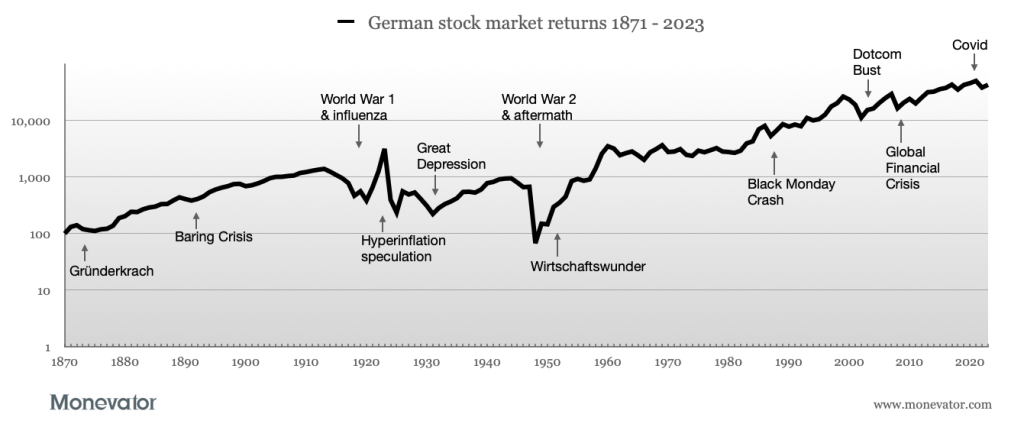
For the final installment of Monevator’s commodities series, I’m going to walk you through my ETF pick for actually investing in this controversial but potentially highly useful asset class.
Of course the recent history of commodities investing has been more troubled than that of an 11-year old arsonist.
We’ve taken four posts just to lay out the pros and cons:
Part one explained how commodities investing works
Part two covered commodities’ long-run returns
Part three examined whether commodities enhanced portfolio returns
Part four investigated whether commodities really are a good inflation hedge for UK investors
But while reasonable minds might disagree on this one, my own conclusion is investing in broad commodities offers me portfolio diversification advantages I can’t get elsewhere.
And now that I’ve researched the available commodities ETFs, I’m satisfied I should be able to pick up a product that can capture the benefits of the asset class, too.
I’ll dive into those details further down.
But first let’s run through my candidates for the best commodities ETFs.
The best commodities ETFs that I can find
My top pick is the nattily named:
UBS ETF (IE) CMCI Composite SF UCITS ETF (USD) A-acc
Ticker: UC15
ISIN: IE00B53H0131
Index: UBS Constant Maturity Commodity Index
OCF: 0.34%
Launched: 20 December 2010
Domicile: Ireland
Replication: Synthetic
Cumulative nominal GBP return: 18.3% (20 December 2010 to 6 July 2023)
This is the ETF I’m going to invest in.
My alternative choice is:
L&G Longer Dated All Commodities UCITS ETF
Ticker: CMFP
ISIN: IE00B4WPHX27
Index: Bloomberg Commodity 3 Month Forward Index
OCF: 0.3%
Launched: 18 March 2010
Domicile: Ireland
Replication: Synthetic
Cumulative nominal GBP return: 9.4% (20 December 2010 to 6 July 2023)
Both these broad commodities ETFs track an index that’s locked on to the fortunes of energy, agriculture, livestock, and industrial and precious metals futures contracts.
That’s a mouthful but it’s what we want to see. (We covered the particulars in a previous commodities investing post.)
Essentially, we want exposure to a diversified range of commodities futures. That’s exactly what we get with these two ETFs.
Here’s the battle of the commodities index trackers across the maximum comparable timeframe:
Source: justETF.
UC15 (red line) comes in comfortably ahead of CMFP (blue line) with a cumulative return of 18.3% to 9.4%.
Though do note the -45% cumulative return chalked up by 2016!
UC15’s better overall return makes it my top pick. But as you’ll see shortly there are reasons you could choose CMFP instead.
There’s certainly no guarantee that UC15 will continue to beat CMFP in the future.
Why did I choose these commodities ETFs?
My main criteria for my best commodities ETF choices are that they:
Track an index that can capture the benefits of the asset class
Have a good long-term track record (relative to mainstream commodities benchmarks)
Have a reasonably low cost
Don’t do anything weird (relative to other broad commodities trackers)
My top two picks tick all those boxes.
I started with the universe of London Stock Exchange broad commodity ETFs listed on justETF, excluding currency-hedged ETFs. As with equities, I want the currency risk associated with commodities (which are denominated in US dollars).
My next stop was to establish which ETFs are doing a decent job of capturing the benefits of the broad commodities market.
My benchmark here is the Bloomberg Commodity Index (BCOM). This is the contemporary version of the investable index I’ve used throughout this series to establish that broad commodities are a worthwhile long-run investment.
(The other well known commodities index is the S&P GSCI, but not a single European ETF tracks it.)
Now, commodities have endured a terrible bear market for most of the period these ETFs have been around. So prepare for your drooling chops to dry when I start bandying around numbers.
Remember we’re here because future expected returns for commodities are estimated to be 3.5% to 4% (annualised real total returns). And because the historical real GBP returns are 4.5% annualised over the past 89 years – trouncing any other asset class that can diversify our equity returns.
Long-term track record
We want our commodities ETF of choice to have matched or beaten the BCOM total return index over the longest possible timeframe.
Both of my top picks launched in 2010, so that’s plenty of time to ascertain whether they work or not.
For comparison, the BCOM total return index delivered a stonking -2.8% nominal cumulative total return (GBP) from 2011 to 2022. (Take me home, mama!)
UC15 earned a 26.7% cumulative return over that period
CMFP earned 21.08%
The point is both ETFs smashed the BCOM return over 12 years.
Which brings me to the next key point…
Your commodities index matters
When you pick a global tracker fund, the index matters, but not that much – just so long as it’s a reputable global equities benchmark.
However we can’t be so complacent with our broad commodities index.
Broad commodity indexes are divided into first generation, second generation, and – oh happy day – third generation iterations.
Second- and third-gen indexes fix some of the known problems with first generation indexes.
Yet the two most popular benchmarks (BCOM and S&P GSCI) are both first-gen originals.
Antti Ilmanen sums up why this commodity index innovation has been a positive in his book Expected Returns on Major Asset Classes:
Nonetheless, the changes made in the new indices appear a priori reasonable: less weight in the energy sector; changes in roll schedules (because monthly rolling from nearby to second contract according to the S&P GSCI’s schedule puts one-sided pressure on market prices and causes temporary price distortions that other traders can exploit or avoid); and, increasingly, a shift from holding only the most liquid nearby futures contract toward including a basket of deferred contracts.
That last point is particularly important.
Because first-gen indexes only track the most liquid short-dated contracts, their returns typically suffer in contangoed markets.
Some second-gen indexes mitigate the problem by including contracts further along the curve.
The indexes followed by both UC15 and CMFP use this technique. And these ‘curve management’ strategies actually work, according to Adam Dunsby and Kurt Nelson in A Brief History Of Commodities Indexes:
By distributing positions across the curve, investors have mitigated this impact and achieved higher returns.
Clearly this approach has paid off for UC15 and CMFP as they’ve both easily outperformed the first-gen BCOM index since launch.
You’ve been contangoed
Sadly, we can’t assume the second-gen indexes will always win. As Dunsby and Nelson explain, UC15’s second-gen UBS CMCI index is better in certain conditions:
When contango is more pronounced in the front end of the futures curve, as is typically the case for, say, corn and has recently been the case for crude oil, then these indexes will outperform the first-generation indexes. When futures markets are backwardated, and the backwardation is concentrated in the front end of the curve, then these indexes will underperform the first-generation indexes.
As for CMFP’s BCOM 3 Month Forward index, Dunsby and Nelson say:
The DJ-UBSCI [BCOM] 3 Month Forward takes a different approach. It invests in the commodities contracts that the traditional DJ-UBSCI would hold three months from now.
This feature places all the DJ-UBSCI F3 contracts farther out the futures curve, and since futures curves tend to be flatter as tenor is extended, the effects of backwardation and contango tend to be reduced.
The market tends to switch between backwardation and contango, but contango has dominated returns over the period since most commodity ETFs were launched.
The risk in plumping for UC15 is that we end up kicking ourselves as a golden age of backwardation inevitably follows, simply because we tried to outwit fate.
Neuroticism aside, the more even-handed approach of CMFP could make sense, despite its less impressive overall return, given that predicting the futures curve is well above our paygrade.
Finally on indices, just in case you’re wondering, Rallis, Miffre, and Fuertes say in Strategic and Tactical Roles of Enhanced-Commodity Indices:
Our findings suggest that the enhanced indices retain the risk diversification and inflation-hedging properties of the traditional S&P-GSCI and DJ-UBSCI [BCOM index].
Commodities ETF alternatives
There is a cheaper way than CMFP to track the BCOM 3 Month Forward Index – namely Xtrackers Bloomberg Commodity Swap UCITS ETF 1C, or XCMC for short.
XCMC’s OCF is only 0.19%, versus 0.3% for CMFP.
The reason I haven’t given XCMC the nod is because it only launched in November 2021.
That said, the two ETFs have been neck-and-neck over the 20 months XCMC has existed. If you don’t mind a short track record, then choosing XCMC on cost grounds looks reasonable as so far it’s hugging its index as effectively as CMFP.
Elsewhere, Xtrackers Bloomberg Commodity ex-Agriculture & Livestock Swap UCITS ETF 2C (XBCU) actually pipped UC15 in a dead-heat for the period 2011 to 2022.
Personally, I don’t want to exclude agriculture and livestock. But if you do then this is the ETF to consider. It follows the Bloomberg ex-Agriculture and Livestock 15/30 Capped 3 Month Forward index.
The UBS ETFs (IE) Bloomberg Commodity CMCI SF UCITS ETF (USD) A-acc (UD07) looks promising but it only launched in 2017. This ETF follows a slightly different 2nd-gen constant maturity index from UC15.
Amundi Bloomberg Equal-weight Commodity ex-Agriculture UCITS ETF Acc (CRBL) is a contender and the only broad commodities ETF available that tracks an equal-weighted index. However, the ETF changed its benchmark in January 2023 making it difficult to know whether its long-term returns are still relevant.
I passed on the Invesco Commodity Composite UCITS ETF Acc (LGCF) for the same index tinkering reasons.
Finally, if you want a first-gen index tracker then check out Market Access Rogers International Commodity UCITS ETF (RICI). It’s consistently outpaced BCOM since 2007.
Of course, you could always divide your commodities’ allocation between a couple of meaningfully different approaches.
You could split your money 50:50 between a first-gen and second-gen ETF.
Or between a second-gen and the equal-weight ex-agriculture option. Academic research into commodities futures shows that equal-weight indexes have historically outperformed their first-gen counterparts.
It depends on your tolerance for portfolio complexity.
Commodities ETF mop-up
ETFs are not covered by the FSCS investor compensation scheme, although you’d still be eligible for support if your broker went bust.
If you invest outside of your tax shelters then make sure your commodity ETFs have UK reporting fund status. Otherwise capital gains will be taxed at your marginal rate of income tax.
If an ETF’s assets under management (AUM) are worth less than $100 million a couple of years after launch, then it may eventually be closed down or merged with another fund.
That doesn’t mean you lose your money, but it can leave you out of the market for a while, or trigger a tax event – potentially annoying if you’re investing outside an ISA or pension.
Note that my top two ETFs are both comfortably over $100 million in AUM.
Commodities ETFs don’t pay dividends but they do reinvest interest earned on collateral. Consult a tax professional if this concerns you.
I haven’t looked at funds that invest in commodity stocks because they are highly correlated with the broader equities market. You need to invest in broad commodities ETFs to get exposure to the diversification benefits we’ve examined in this series.
Swap shop
Commodities ETFs use total return swaps to track their indexes. A total return swap is a derivative, provided by a third-party who undertakes to pay the ETF the return of the index (minus costs).
This arrangement means commodities ETFs don’t actually invest in futures contracts, never mind shipments full of lean hogs, bales of cotton, or barrels of oil.
Index trackers that use total return swaps are classified as synthetic ETFs and it’s as well to know what that entails.
In reality, each synthetic ETF’s holdings amount to a basket of securities that have nothing to do with commodities and are held as collateral. This is standard practice.
The collateral is there to cover investors against counterparty risk – the chance that the swap provider fails to pay out during some kind of financial crisis.
On that basis, make sure to check that your chosen ETF’s website indicates the tracker is backed by collateral worth at least 100% of its market value.
Commodities ‘coaster
Broad commodities had an awesome 2021 and 2022. But the asset class is hovering around correction territory (-10%) so far in 2023.
If that gives you the heebie-jeebies then commodities are not for you.
They suffer equity-scale volatility and can spend years – even decades – underwater.
Eruptions into positive territory can be brief but spectacular, like watching the geyser Old Faithful blow its spout in Yellowstone Park.
But there’s no point investing in commodities if years of negative returns turn you into Old Unfaithful – ditching your holding and so failing to collect when returns sky rocket.
Personally, I’m still nervous about commodities. But I’ve been persuaded by the long-run data that shows the asset class can work when others fail.
For this reason, I’m going to take the plunge now I’ve homed in on a couple of commodities ETFs that look up to the job.
That said, I will proceed cautiously. I’ll start by switching a few percentage points of asset allocation, then build up my position slowly over the next couple of years, or whenever the market takes a downward lurch.
With commodities – more than my other asset classes – I want to minimise any early regrets, get comfortable, and then hunker down for the long-run.
Take it steady,
The Accumulator
More ETfs for fun and profit:
For other asset classes check out our cheapest trackers guide
Our best global equity trackers suggestions
Here are our best bond fund choices
The post Which commodities ETF? appeared first on Monevator.



